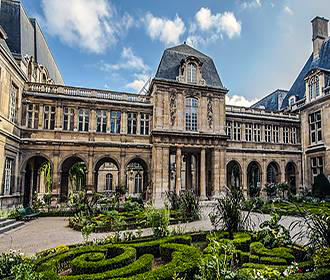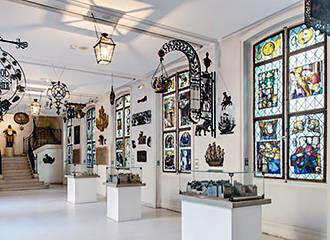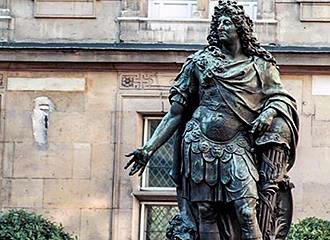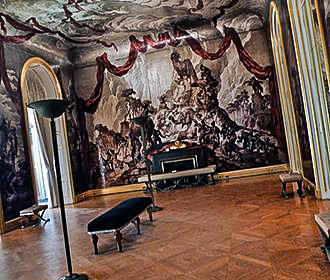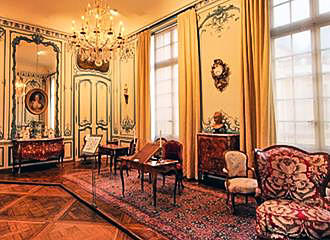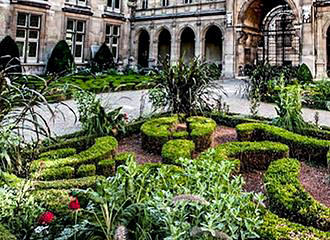Paris Hotel Carnavalet Mansion House
This remarkable mansion house is one of the oldest in the Marais area of the capital city and being a rare example of Renaissance architecture, it was originally constructed in 1548, yet is now home to the Musee Carnavalet, which is the Museum of the history of Paris.
Beginnings of the Hotel Carnavalet Mansion
The original hotel called the Hotel des Ligneris, was constructed between the years of 1548 and 1560 for Jacques des Ligneris, who was the President of the Parliament of Paris, yet it looked very different at that time to what you will see today.
In fact, originally there was one main building at the back of the courtyard with different levels, but the other three sides to the construction, or wings, were originally only built to be on one level.
Yet the entrance creates a great impression with its allegories in strong relief, plus there are impressive sculptures that were produced to adorn the facades, which were created by Jean Goujon, who designed the Fontaine des Innocents that is now the oldest fountain in Paris.
Within the courtyard you will see the four seasons represented by figures located at the first floor windows and above these are the corresponding zodiac signs of Aries for spring, Cancer for summer, Libra for autumn and Capricorn for winter.
You can also see the mascarons, which are like faces of horned creatures, that adorn the faces of the ground floor, plus there were also stables constructed, and today the entrance to the Musee Carnavalet is reached through the arcades of the old stables.
However, it was not until 1578 that it got the name it has today, and this actually stemmed from a distortion of the name of the next owner, who was Madame de Kernevenoy de Bretagne.
The Next Stages of Hotel Carnavalet in the 17th Century
It was then in 1655 that the new fourth owner, Claude Boisleve, wanted the Hotel Carnavalet altered and expanded, and it was he who decided to have the pavilion built over the arch.
Much of the work was also entrusted to the famous architect Francois Mansart, who also played a major role in the construction of the Church of Val-de-Grace for Anne of Austria.
And work started on the Hotel Carnavalet in 1655, where the main entrance was raised in height, along with sculptures depicting the figures of virtues and the four elements were put in place on the additional floors of the side wings to complement the four seasons at the back of the courtyard. The higher buildings and modification of the side wings, meant that they ended up having gambrel style roofs, which Francois Mansart was famed for.
Then Madame de Sevigne resided there from 1677 through to 1696, and it continued to be a private residence right up until the end of the Ancien Regime, yet during the first half of the 19th century is occupied by different educational institutions.
The Hotel Carnavalet turned into a Paris Museum
It was in 1866 during the transformation of Paris by Baron Haussmann that the Hotel Carnavalet was purchased by the city in order to restore the building and transform it into a museum on the history of Paris.
Baron Haussmann commissioned the young architect Victor Parmentier to oversee the restoration, yet fortunately the modifications made by Francois Mansart on the side wings were preserved although the gambrel roofs were replaced with flat roofs, and some aspects were returned to the original designs.
However, with the destruction that happened throughout the city during the Paris Commune, the collections that were intended for this new Paris museum were destroyed by fire, and therefore the Musee Carnavalet did not open straight away.
To start with, the Bibliotheque Historique de la Ville de Paris, which is the historical library that was founded from the private collection of Jules Cousin after the original was lost by fire, was installed in the Hotel Carnavalet in 1872, and then eventually in 1880 the museum dedicated to the history of Paris also opened its doors.
However, because the installation of the library was not intended to be at the Hotel Carnavalet, as it had originally been at the Hotel de Ville, or town hall, this meant that additional wings needed to be constructed to house the collections.
So, several different elements were collected from other places that were being demolished such as the Arch of Nazareth that dated from 1552, the facade of a cloth merchants dating from 1660 and decor from the Hotel de l’Abbe la Riviere that had been designed by Charles le Brun.
Then the historical library was moved to the recently acquired Hotel le Peletier de Saint-Fargeau, so that the historical collections and artefacts could have more space and the museum could expand further.
Yet, the place still needed to be expanded further and work started in 1907, yet was halted due to World War I and was not completed until 1920, then buildings were constructed around the Henri IV courtyards and later again around the Victoire courtyard.
The garden beds were transformed back into a classical style and sculptures put in place, such as the original sculpture by Louis Boizot from the Palmier Fountain at the Square du Chatelet, as this was replaced with a replica.
However, even the Hotel le Peletier de Saint-Fargeau now holds several sections of the Musee Carnavalet and was joined by a gallery on the first floor to the Musee Carnavalet, as the impressive collection of the museum had to expand yet again.
So, as you can tell, the Hotel Carnavalet has a rich and varied history, and although the Musee Carnavalet is well worth a visit because of its impressive collections, the Hotel Carnavalet is also a fascinating building, both for its architecture, design and its decor.
